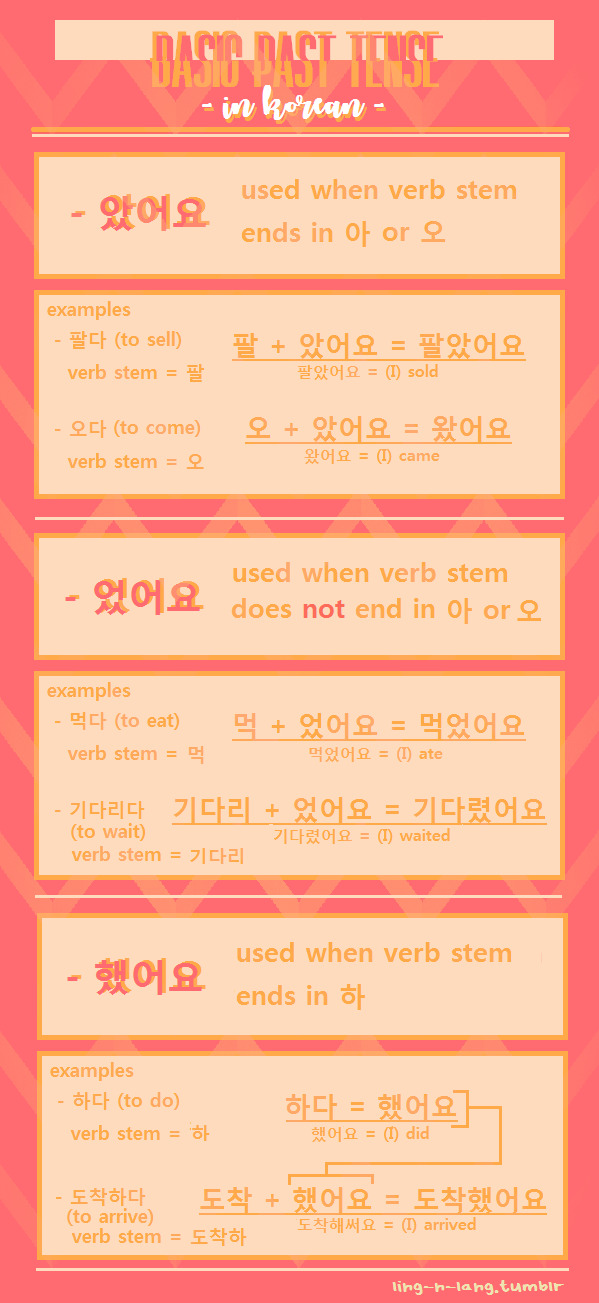Text
Some slang specific to Twitter/fan communities
Twitter
계폭 (계정 + 폭파) deletion of account (비활성화시키다 means to deactivate)
인장 profile pic, 헤더 header
실사인장 profile picture of an actual person (as opposed to pictures of anime, animals, nature, etc.)
애니프사 (애니메이션 프사) anime profile pic
본계 main account
부계 secondary account (there are multiple types secondary accounts: 사담계 is an account on which you talk about your daily life, 뒷계 is a back account, often with nsfw content)
플텍계 a protected account
알계 (알 means egg) an account with an egg as their profile picture
계실 (계정 실수) when you have multiple accounts you might tweet on one or the other by accident. That's an account mistake or 계실.
계이 (계정 이동하다) to move to another account
동결 (lit. to freeze) to be inactive/hiatus
반동결 to be semi-inactive
A word similar to 동결 is 휴트 (트위터 휴식), which literally means "to take a break from Twitter."
구독계 an account that is used only for looking and following other people, not for tweeting/interacting (can be used as a verb 구독하다, to follow only to look)
관음 this is a more extreme form of 구독. While 구독 is simply following someone just to look and without interacting with them, 관음 is full on stalking, looking through their pictures, their mentions, etc.
멘션스루 (스루 as in the English word "through") to ignore mentions or not being able to reply to mentions
타래 a thread
흔적을 남기다 (lit. to leave a trace) to like and/or retweet a tweet. Often this means the person will come "get you" (찾아가겠습니다!) by mentioning you in order to become close.
무멘팔 (아무 멘션 팔로워하기) to follow without even mentioning + 선팔 to follow first, 맞팔 to be mutuals, 언팔 to unfollow
블언블 block then unblock (so someone stops following you)
FUB FREE (follow, unfollow, block free) means that you can follow, unfollow and block as you wish and they don't care. That's because often if you unfollow someone, they'll block you, so this is a way of saying "don't worry I won't block/unfollow you if you unfollow me."
트친 (트위터 친구) is a Twitter friend, so 겹트친 (or 겹트) is a Twitter friend of a Twitter friend
유령 to be shadowbanned (유령계 a shadowbanned account) -> this is when even if you mention someone, they can't see your tweets in their mentions
트청 (트윗창소) cleaning of one's tweets
트정 (트친 정리) means to clean one's Twitter friends (as in, check if someone unfollowed you and unfollow them back/block them, unfollow inactive accounts, etc.)
사찰 to spy/inspect sb else's account
Fan communities
드림캐 character which already exists in a published work (ex. in a manhwa, an anime, a drama, a book, a movie, etc.) and with which you ship your 드림주
드림주 character created by a fan to add to an already existing fiction work (example: writing a Harry Potter fanfic and adding your own original character)
드림 situation in which your original character and the already existing character are thrust together romantically often though fanfiction, drawings, etc. In this situation, your 드림캐 and 드림주 make up your 드림커플 (dream couple).
드림러 is the name of a person who does 드림
겹드림 is the name given to a work involving a couple with a 드림캐 (already existing character) and somebody else's 드림주 (original character)
온리드림 is when a 드림러 refuses to look at someone else's 겹드림
오픈드림 is when a 드림러 doesn't mind looking at someone else's 겹드림
자캐 (자작 캐릭터) one's own character that one has created
오너캐 one's own character that one has created, but that is supposed to represent oneself (ie. an avatar of sorts)
163 notes
·
View notes
Text

So, if you’re just getting started on conjugating verbs and adjectives in Korean, the first thing to know is that there are two parts to the words.

The word ‘stem’ is the main part of the word. It is the part that stays constant and never-changing.

The word ‘ending’ is the actual part of the word that gets conjugated.

If you’re going to look up a verb in a dictionary, it will be in its infinitive form, so it’s basically not conjugated. These verbs will end in 다, so it’s up to you to conjugate it.
In Korean, conjugation depends on 4 things at least:
Sentence tense
Politeness level
Passive and causative forms
Speech styles
Keep reading
2K notes
·
View notes
Photo

basic polite present tense - korean info from TTMIK 1.16
1K notes
·
View notes
Photo



So I’ve seen people asking/looking for places to practice verb conjugation, and while there are sites that will give you the conjugations for a verb, there hasn’t been any practice sheets I’ve seen like for other languages.
So in an effort to do something a bit worthwhile while procrastinating, I decided to try my hand at making one for Korean!
I tried to include the major tenses learned in level 1-2, with some of the most common connective suffixes too. Below the suffixes is noun modifiers, which is how you create adjective form verbs. I also included a little place for you to take any notes. (It should be noted my * and - note on either example sheet are actually rules to remember.)
But anyway, I hope people can find these useful! Feel free to share, but please do credit me (my url is at the top of the sheet) If there’s any questions or things you think I missed please let me know~ The sheet (both colored and white) and the two examples, can be found here (I’ll also add it to my masterlist)
2K notes
·
View notes
Text
Beginner’s Course

Beginner’s Course 1/10
Beginner’s Course 2/10
Beginner’s Course 3/10
Beginner’s Course 4/10
Beginner’s Course 5/10
Beginner’s Course 6/10
Beginner’s Course 7/10
Beginner’s Course 8/10
Beginner’s Course 9/10
Beginner’s Course 10/10
2K notes
·
View notes
Note
hi, are formal polite style and honorific expression two different things? i read in a book that formal polite style for 가다 is 갑니다 while the honorific expression is 가십니다 also what about 갑시다?
(I got another ask from the same Anon saying to disregard the 갑시다)
Hi! Technically yes, polite and honorific speech are two different things. I wouldn’t worry too much about which is referred to as “polite” and which are referred to as “honorific” or “formal” and stuff. Rather, it’s more useful to know the level of politeness each form holds, if that makes sense.
There are a lot of different levels of formality, but some are more common than others. I’ll give you a breakdown of the most common ones from most to least formal!
1. Very Formal
If you add -ㅂ니다 / -습니다 to a verb or adjective stem, it becomes the declarative form (just basic present tense). For example:
만나서 반갑습니다 = It’s nice to meet you
If you add -(으)십시오 to a stem, it becomes a very formal command. For example:
여기 앉으십시오 = Please sit here
As you mentioned, adding -십니다 is also very formal and is another way to make an imperative sentence. From what I know, however, this form is less common and I rarely ever see it being used. I would say to only use it in very very formal contexts!
2. Formal (more common)
This is probably the form you’ll hear the most. It’s used for talking to people you just met and people like coworkers and such. It’s also used for people older than you (although again, if that person is an elder, you should probably use the first form).
Simply add -아/어/여요 to make a declarative sentence:
저는 학교에 가요 = I go to school
Technically the sentence without the 저는, which means “I,” could either mean “I go to school” pr “go to school” as a command. But generally I would say be safe and don’t use a sentence like this as a command. Rather, use the following:
Add -(으)세요 to make an imperative sentence:
학교에 가세요 = Please go to school
3. Informal
Informal sentences should be used when talking to someone who is the same age as you and who you’re comfortable with.
Add -아/어/여 to make a declarative OR imperative sentence -- it will generally be understood which you’re saying:
나는 학교에 가 = I go to school (나 is the informal way to say “I”)
학교에 가 = Go to school
That was just a quick breakdown and I hope I answered your question! I would highly recommend checking out the following lessons for more in-depth info!
Present Tense Conjugations and Formal Language
Honorifics and Casual Language
Giving Commands / Asking Questions
Negative Commands
-시
Of course there are so many ways to give commands, but those are the essentials! As you progress in your studies, you’ll learn even more ways! 화이팅!
80 notes
·
View notes
Photo

| sources |
studying japanese resources by @fuckstudy
japanese resources by @gachagachagogo
hiragana chart by @linguajunkie
hiragana matching game by @dolleye
japanese learning cheat sheets by misshoneyvanity
300 basic words by @nihongogogo
onomatopoeic words by @tsunbutt
giant guide to self-teaching japanese by @mikuyami
japanese learning resources + advice by @deskowl
ultimate japanese resource list by @benkyogo
guide to self-studying japanese by @benkyogo
useful japanese learning shit by @4000yearsofexperience
cute doodle cheat sheets by kirakiradoodles
japanese learning resources by @japanese-revision
japanese studying resources by @nihongotime
japanese language learning websites by @saintlydemon
japanese grammar packet by @teijin
language learning masterpost by @z-co
online japanese textbooks by @moonprincess
japanese learning resources by hangukdrama
japanese textbooks by hangukdrama
resources by tofugu
resources by gakuu
resources by @nihongokudasai
best sites for learning japanese by nihongoshark
| dictionaries |
Jisho.org
Jim Breen’s JDIC
Yamasa Kanji Dictionary
Kodansha Kanji Learner’s Dictionary
Dictionary of Japanese Grammar
| textbooks |
Textfugu
Minna no Nihongo
Genki
Heisig’s Remembering the Kanji
Tobira
This blog has a ton of pdf files
| grammar |
Tae Kim’s Guide to Learning Japanese
Marugoto
The Japanese Page
Tim’s Takamatsu
Visualising Japanese Grammar
Nihongo Resources
Sci Lang Japan FAQ
JGram
Renshuu
Tatoeba
Learn Japanese with Erin
Tanos
An Introduction to Japanese - Syntax, Grammar & Language
| vocabulary |
Memrise
WordReference Forums
Renshuu
6000 most used words
Large Phrase List
Japanese Onomatopoeia
Keigo Cheatsheet
| kana |
Hiragana 42
RealKana
Hiragana & Katakana Shape Comparison
Tofugu Hiragana Chart
Tofugu Katakana Chart
Introduction to Japanese Characters
| kanji |
Reviewing the Kanji
Read the Kanji
Kanji Radical Stroke Order
GSCE Picture Kanji Cards
WaniKani
Kanji Damage
Kanji Repeater
Go Kanken
| tools + apps |
Rikaichan / Rikaikun
Rikai
Hiragana Megane
Kantango
Anki
Lang-8
Renshuu.org
Rhinospike
Skritter
Hi Native
Forvo
FluentU
| reading |
Tokyo International University Reading Tutor
Hiragana Times
Choko Choko Reading Section
JLPT Example Questions
Maggie Sensei
List of Japanese Audiobooks and Transcripts
TUFS Learning Resources
Kotonoha
Tatoeba
NHK News
The Great Library
Famous Stories
Read More Or Die
Macaronics
The Great ChokoChoko Library
Japanese Reading Practice For Beginners
Kodomo Asahi (Kid’s Asahi News)
Yahoo! Kids Japanese Papercraft
Read Manga Online
Chunichi Kid’s News
Real World Japanese
Japanese Class News Reading
ECIS インタネット放送局
| listening |
Erin’s Challenge!
RhinoSpike
NHK Easy News
KeyHole TV
NHK WORLD TV
Documentaries About Japan You Can Watch For Free
Studying with J-Drama
Nihongo de Kurasou
Stream Japanese TV Online
Beb & Alex Podcast
どぉ~でもいいNEWS
坂本真綾 from everywhere
恋愛心理学知りたい!
相手の気持ち
NHKラジオニュース
* The ones in bold are my faves
* But I advise you to watch LearningJapanese!! Like this guy literally taught me from Kana to Intermediate Grammar, which has been a very good improvement
22K notes
·
View notes
Text
גוליית כשהוא ראה את דוד עם הרוגטקה

2K notes
·
View notes
Text
Grammar
First and foremost- if I’ve made a mistake, please let me know so I can fix it ∩^ω^∩
Aside from learning Volitional form (aka “let’s… / shall we?”) my class also learned how to use
前に - before
後で - after
れい:
Noun + の (・Dict. Form) + 前に
勉強する前に買い物に行こう
べんきょうする・まえに・かいものに・いこう
“Let’s go shopping before studying” or “Before studying, let’s go shopping”
夕飯の前に私は映画を見た
ゆうしょくの・まえに・わたしは・えいがを・みた
“Before dinner, I saw/watched a movie” or “I saw/watched a movie before dinner”
Noun + の (・た form) + 後で
仕事の後で私はカラオケに行った
しごとの・あとで・わたしは・カラオケに・いった
“After work, i went to karaoke” or “I went to karaoke after work”
動物園に行った後で私達は家に帰った
どうぶつえんに・いった・あとで・わたしたちは・いえに・かえった
“After going to the zoo, we returned/went home” or “We returned/went home after going to the zoo”
*Side note* the (dict. form/ た-form) are for verbs
102 notes
·
View notes
Text
Beginners Japanese textbooks
So I get a lot of questions here and on Instagram about the books I use for Japanese and what I would recommend to beginners. So I thought I’d put together a little list of books I would suggest you start off with as a beginner in Japanese (these are all books I have used myself or had/would consider using) Obviously I’m not saying you need all of these books, pick one and see how it goes (although I do recommend using more than one resource)! I may do another post like this for intermediate learners if there’s enough interest (with the textbook series they will take you to a higher level, but this is just recommendations as a starting point) ^^
Learning Hiragana and Katakana Flashcards
Japanese Kanji Flashcards Volume 1
Japanese Kanji for Beginners
Japanese From Zero Series
Kana From Zero | Hiragana From Zero | Katakana From Zero | Kanji From Zero
Japanese From Zero 1 | Japanese From Zero 2 | Japanese From Zero 3 |
Japanese From Zero 4
Genki Series
Level 1 textbook | Level 1 workbook | Level 2 textbook | Level 2 workbook
Japanese For Busy People Series
Kana workbook | Level 1 kana ver | Level 1 romaji ver | Level 2
Basic Japanese
Japanese for Beginners
A Dictionary of Basic Japanese Grammar
Essential Japanese Grammar
Essential Japanese Vocabulary
600 Basic Japanese Verbs
6K notes
·
View notes
Photo

Common Japanese Verbs Hey guys, below is a list of what I believe to be common Japanese verbs! I’ll also be posting a list of common adjectives, adverbs, and nouns in the future too, so keep an eye out for them! There are a number of ways that verbs have been categorised in Japanese, such as Ichidan 「一段」 and Godan 「五段」, and う verbs and る verbs. I’ve listed them all in the titles for easier understanding, depending on what distinction you’re familiar with. These classifications come in handy when you need to conjugate verbs so try to remember what category they belong to! うverbs・五段「ごだん」・Class 1: To begin (something starts on its own)・始まる・はじまる To buy・買う・かう To close・閉まる・しまる To die・死ぬ・しぬ To drink・飲む・のむ To eat・食べる・たべる To end・終わる・おわる To enter・入る・はいる To give back (return something to someone)・返す・かえす To go・行く・いく To go back・戻る・もどる To have/exist (inanimate objects)・ある To know・知る・しる To learn・習う・ならう To listen・聞く・きく To make・作る・つくる To meet・会う・あう To play・遊ぶ・あそぶ To receive・貰う・もらう To repair・直す・なおす To return・帰る・かえる To ride on・乗る・のる To run・走る・はしる To send・送る・おくる To sit・座る・すわる To speak・話す・はなす To swim・泳ぐ・およぐ To take・取る・とる To take off (shoes, clothes)・脱ぐ・ぬぐ To understand・分かる・わかる To use・使う・つかう To wait・待つ・まつ To wake up・起こす・おこす To wash・洗う・あらう To write・書く・かく るverbs・一段「いちだん」・Class 2: To answer・答える・こたえる To bathe・浴びる・あびる To be able・出来る・できる To be born・生まれる・うまれる To be enough・足りる・たりる To begin (to start something)・始める・はじめる To borrow・借りる・かりる To break・壊れる・こわれる To check・調べる・しらべる To cut・切れる・きれる To exceed・過ぎる・すぎる To find・見つける・みつける To forget・忘れる・わすれる To get off・降りる・おりる To get tired・疲れる・つかれる To give・あげる To go out・出る・でる To greet・迎える・むかえる To have/exist (animate objects)・いる To help・助ける・たすける To make a mistake・間違える・まちがえる To open・開ける・あける To remember・覚える・おぼえる To see・見える・みえる To show・見せる・みせる To sleep・寝る・ねる To stop・止める・やめる To teach・教える・おしえる To think・考える・かんがえる To wear・着る・きる Irregular verbs・Class 3: To come・来る・くる To do・する
する verbs: する verbs are made by adding する to a noun. To ask questions・質問する・しつもんする To be surprised・びっくりする To call・電話する・でんわする To do the cleaning・掃除する・そうじする To do the washing・ 洗濯する・せんたくする To get married・結婚する・けっこんする To go shopping・買い物する・かいものする To have a meal・食事する・しょくじする To reserve・予約する・よやくする To study・勉強する・べんきょうする To take a walk・散歩する・さんぽする To travel・旅行する・りょこうする
7K notes
·
View notes
Photo
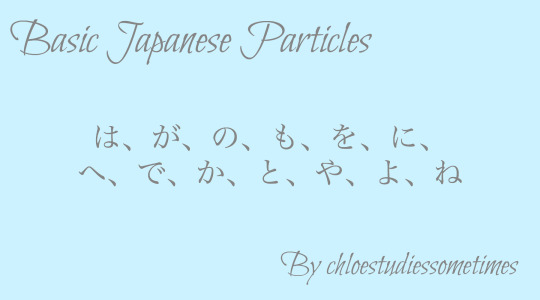
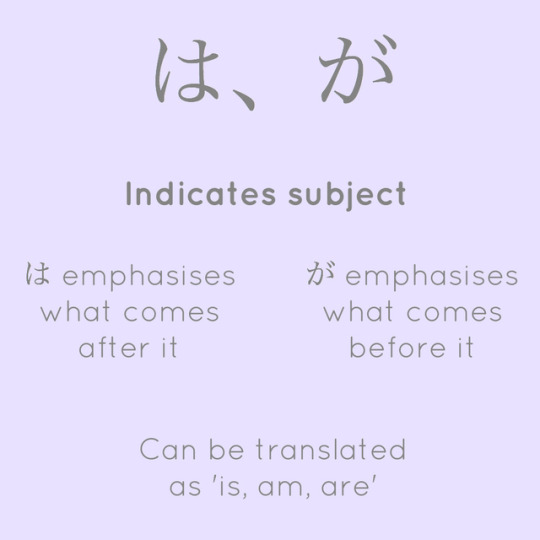



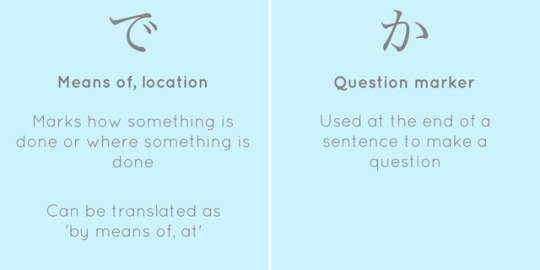

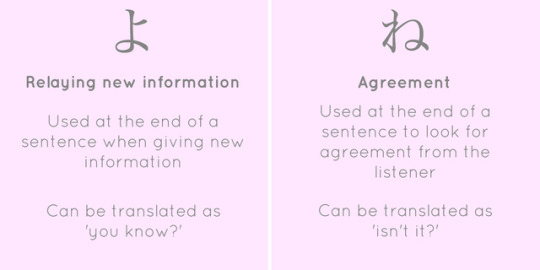
I’ve been meaning to make this post for a while, and I got an anon the other day asking about particles and a request from someone to make this post, so here it is! A list of basic particles and their usage! I hope this can help anyone struggling with particles and how to use them, but if I have made any mistakes please let me know ^^ (also please don’t remove my caption!)
15K notes
·
View notes



